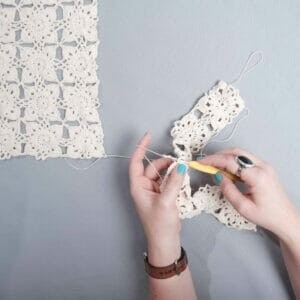Is learning crochet difficult? Let’s explore the journey of mastering this rewarding craft, offering insights and guidance with Learns.edu.vn. Discover valuable tips, techniques, and resources that simplify the learning process and make crochet accessible to everyone. Explore crochet complexity, basic stitches, and beginner projects with us.
1. Understanding the Crochet Learning Curve
Crochet, with its rhythmic hook movements and beautiful creations, can seem daunting to beginners. However, like any skill, learning to crochet involves a learning curve. Understanding this curve can help you approach the craft with realistic expectations and a positive mindset.
- The Initial Hurdle: The first few steps are often the most challenging. Learning to hold the hook and yarn, creating a slip knot, and mastering basic stitches like the chain stitch, single crochet, and double crochet can feel awkward at first.
- Building Muscle Memory: Repetition is key. As you practice, your hands will develop muscle memory, making the movements smoother and more natural.
- Pattern Reading and Complexity: Once you’ve mastered the basics, you can start exploring patterns. Simple patterns are easy to follow, but more complex patterns can introduce new techniques and stitch combinations that require patience and attention to detail.
- Troubleshooting and Problem-Solving: Every crocheter encounters mistakes. Learning to identify and fix errors, whether it’s a dropped stitch or an incorrect count, is an essential part of the learning process.
- Continuous Learning: Crochet offers endless possibilities for creativity and growth. As you become more experienced, you can experiment with different yarns, hook sizes, stitch patterns, and techniques to create unique and intricate projects.
2. Factors Influencing Crochet Difficulty
The perceived difficulty of learning crochet can vary depending on several factors:
- Prior Experience: If you have experience with other crafts like knitting or sewing, you may find it easier to grasp the basic concepts of crochet.
- Learning Style: Some people learn best through visual tutorials, while others prefer written instructions or hands-on guidance. Choosing a learning method that suits your style can make the process more enjoyable and effective.
- Patience and Perseverance: Crochet requires patience and perseverance. It’s important to be kind to yourself and not get discouraged by mistakes.
- Quality of Resources: High-quality tutorials, patterns, and instructors can make a significant difference in your learning experience.
- Support and Community: Having access to a supportive community of crocheters can provide encouragement, advice, and inspiration. Websites like Learns.edu.vn can offer a wealth of resources and connect you with fellow enthusiasts.
3. Dispelling Common Crochet Myths
Several myths surround crochet, often making it seem more complicated than it is. Let’s debunk some of these misconceptions:
- Myth 1: Crochet is only for grandmothers: Crochet is a versatile craft enjoyed by people of all ages, genders, and backgrounds.
- Myth 2: Crochet is too difficult to learn: With the right resources and a willingness to practice, anyone can learn to crochet.
- Myth 3: Crochet is expensive: You can start crocheting with a basic hook and a ball of yarn, making it an affordable hobby.
- Myth 4: Crochet patterns are impossible to understand: Simple patterns are easy to follow, and more complex patterns become easier with practice.
- Myth 5: Crochet is only for making doilies: Crochet can be used to create a wide range of items, from blankets and clothing to toys and home decor.
4. Essential Skills to Master for Beginners
To embark on your crochet journey, focus on mastering these essential skills:
4.1 Basic Crochet Stitches:
- Slip Knot: The foundation of any crochet project.
- Chain Stitch (ch): Used to create the foundation chain and for various decorative purposes.
- Single Crochet (sc): A tight, dense stitch perfect for amigurumi and creating sturdy fabrics.
- Half Double Crochet (hdc): A taller stitch than single crochet, creating a slightly looser fabric.
- Double Crochet (dc): A versatile stitch used in many patterns, creating a fabric with good drape.
- Treble Crochet (tr): The tallest of the basic stitches, creating a very open and airy fabric.
4.2 Reading Crochet Patterns:
- Understanding Abbreviations: Crochet patterns use abbreviations to save space. Learn the common abbreviations for stitches and techniques.
- Following Stitch Counts: Pay close attention to the stitch counts in each row or round to ensure your project comes out the right size.
- Recognizing Pattern Repeats: Many patterns involve repeating a sequence of stitches. Learn to identify these repeats and follow them accurately.
4.3 Holding the Hook and Yarn:
- Experiment with Different Grips: There’s no one “right” way to hold the hook and yarn. Experiment with different grips to find what’s most comfortable for you.
- Maintain Consistent Tension: Consistent tension is key to creating even and beautiful crochet fabric. Practice maintaining a steady pull on the yarn.
4.4 Weaving in Ends:
- Secure the Ends: Use a yarn needle to weave the ends of your yarn securely into your finished project.
- Hide the Ends: Make sure the ends are hidden so they don’t unravel or detract from the appearance of your work.
5. Step-by-Step Guide to Learning Crochet
Follow this step-by-step guide to get started with crochet:
- Step 1: Gather Your Supplies: You’ll need a crochet hook, yarn, and a pair of scissors. Choose a hook size that matches the yarn weight.
- Step 2: Create a Slip Knot: Make a loop with your yarn, insert the hook into the loop, yarn over, and pull through to create a slip knot.
- Step 3: Chain Stitch: Yarn over and pull through the loop on your hook. Repeat to create a chain.
- Step 4: Single Crochet: Insert the hook into the second chain from the hook, yarn over, pull through (two loops on hook), yarn over, and pull through both loops.
- Step 5: Practice, Practice, Practice: Practice the basic stitches until you feel comfortable with them.
6. Choosing the Right Yarn and Hook for Beginners
Selecting the right yarn and hook is crucial for a positive learning experience:
- Yarn: Opt for a smooth, light-colored yarn in a medium weight (worsted or DK). Light colors make it easier to see your stitches. Avoid fuzzy or textured yarns, as they can be difficult to work with.
- Hook: Choose a hook size that corresponds to the yarn weight. The yarn label will usually recommend a hook size. Start with an aluminum or bamboo hook, as they are easy to grip.
| Yarn Type | Recommended Hook Size | Project Examples |
|---|---|---|
| Worsted Weight | H/8 (5.0 mm) | Blankets, scarves, hats |
| DK Weight | G/6 (4.0 mm) | Baby clothes, lightweight garments |
| Sport Weight | E/4 (3.5 mm) | Socks, fine detail work |
| Bulky Weight | K/10.5 (6.5 mm) | Chunky blankets, oversized sweaters |
| Super Bulky Weight | N/15 (10.0 mm) | Quick projects, extreme texture creations |





7. Simple Crochet Projects for New Learners
Start with these simple projects to build your skills and confidence:
- Chain Bracelet: Practice your chain stitch and create a simple bracelet.
- Dishcloth: Make a basic dishcloth using single crochet or half double crochet.
- Scarf: Create a simple scarf using double crochet or treble crochet.
- Granny Square: Learn to make a classic granny square, which can be used to create blankets, bags, and more.
- Simple Hat: Crochet a basic beanie using single crochet or half double crochet.
8. Common Mistakes to Avoid When Starting Crochet
Be aware of these common mistakes to avoid frustration:
- Tight Tension: Crocheting too tightly can make it difficult to insert the hook and create even stitches.
- Inconsistent Tension: Inconsistent tension can lead to uneven fabric.
- Incorrect Stitch Counts: Double-check your stitch counts to ensure your project comes out the right size.
- Skipping Stitches: Be careful not to skip stitches, as this can create holes in your fabric.
- Ignoring Pattern Instructions: Read the pattern instructions carefully and follow them step by step.
9. Tips and Tricks to Make Learning Crochet Easier
Here are some helpful tips and tricks to simplify your crochet journey:
- Watch Video Tutorials: Visual learners benefit greatly from video tutorials.
- Join a Crochet Group: Connect with other crocheters for support and inspiration.
- Practice Regularly: Even short practice sessions can help you improve your skills.
- Be Patient: Don’t get discouraged by mistakes. Everyone makes them, especially when starting out.
- Celebrate Your Progress: Acknowledge and celebrate your accomplishments, no matter how small.
10. Benefits of Learning Crochet
Learning crochet offers numerous benefits:
- Stress Relief: The rhythmic movements of crochet can be very relaxing and therapeutic.
- Creativity: Crochet allows you to express your creativity and create unique, handmade items.
- Mindfulness: Crochet requires focus and attention, promoting mindfulness and reducing anxiety.
- Sense of Accomplishment: Completing a crochet project can provide a great sense of accomplishment.
- Community: Crochet connects you with a community of like-minded individuals.
11. Advanced Techniques to Explore After Mastering the Basics
Once you’re comfortable with the basic stitches, explore these advanced techniques:
- Colorwork: Learn to change colors within a project to create stripes, patterns, and motifs.
- Texture Stitches: Experiment with different stitch combinations to create textured fabrics.
- Lace Crochet: Create delicate and intricate lace patterns.
- Tunisian Crochet: Explore this unique technique that creates a dense, woven-like fabric.
- Amigurumi: Learn to crochet cute and cuddly stuffed animals.
12. Online Resources and Communities for Crochet Learners
Take advantage of these online resources:
- Learns.edu.vn: Offers a wealth of crochet tutorials, patterns, and articles.
- YouTube: Find countless video tutorials for all skill levels.
- Ravelry: A popular online community for knitters and crocheters, offering patterns, forums, and project inspiration.
- Craftsy: Offers online crochet classes taught by expert instructors.
- Etsy: Find unique crochet patterns and supplies from independent designers.
13. How to Troubleshoot Common Crochet Problems
Learn to troubleshoot these common crochet problems:
- Holes in Fabric: Check your stitch counts and make sure you’re not skipping stitches.
- Curling Edges: Adjust your tension or try a different stitch pattern.
- Uneven Fabric: Maintain consistent tension and block your finished project.
- Yarn Splitting: Use a hook with a smoother surface or try a different yarn.
- Tangled Yarn: Wind your yarn into a ball or use a yarn bowl to prevent tangling.
14. The Importance of Practice and Patience in Crochet
Remember that practice and patience are essential for success in crochet:
- Practice Regularly: Set aside time each day or week to practice your crochet skills.
- Start Small: Begin with simple projects and gradually work your way up to more complex ones.
- Be Patient: Don’t get discouraged by mistakes. Everyone makes them, especially when starting out.
- Celebrate Your Progress: Acknowledge and celebrate your accomplishments, no matter how small.
- Enjoy the Process: Crochet should be a relaxing and enjoyable hobby.
15. Crochet Terminology: US vs. UK
Be aware of the differences in crochet terminology between US and UK patterns:
| US Term | UK Term |
|---|---|
| Single Crochet | Double Crochet |
| Half Double Crochet | Half Treble Crochet |
| Double Crochet | Treble Crochet |
| Treble Crochet | Double Treble Crochet |
Always check the pattern to see whether it uses US or UK terminology.
16. Ergonomics and Avoiding Strain While Crocheting
Pay attention to ergonomics to avoid strain and injury:
- Good Posture: Sit with good posture and support your back.
- Proper Lighting: Ensure you have adequate lighting to see your stitches clearly.
- Take Breaks: Take frequent breaks to stretch your hands, wrists, and arms.
- Use Ergonomic Hooks: Consider using ergonomic hooks with comfortable grips.
- Listen to Your Body: Stop crocheting if you experience pain or discomfort.
17. Inspiring Crochet Projects to Motivate Your Learning
Stay motivated by exploring these inspiring crochet projects:
- Afghans and Blankets: Create cozy and colorful afghans and blankets for yourself or as gifts.
- Garments: Crochet sweaters, cardigans, hats, scarves, and other clothing items.
- Accessories: Make bags, purses, jewelry, and other accessories.
- Home Decor: Crochet pillows, coasters, wall hangings, and other home decor items.
- Toys: Crochet amigurumi animals, dolls, and other toys.
18. Connecting with the Crochet Community for Support and Inspiration
Join the vibrant crochet community:
- Local Crochet Groups: Attend local crochet groups to meet other crocheters and learn from each other.
- Online Forums: Participate in online crochet forums to ask questions, share your projects, and get feedback.
- Social Media: Follow crochet designers and bloggers on social media for inspiration and tutorials.
- Crochet Guilds: Join a crochet guild to access resources, classes, and events.
19. The Future of Crochet: Trends and Innovations
Stay up-to-date with the latest trends and innovations in crochet:
- Sustainable Yarns: Explore eco-friendly yarns made from recycled materials or plant-based fibers.
- Innovative Stitch Patterns: Discover new and unique stitch patterns that push the boundaries of crochet.
- Technology Integration: Use apps and software to design your own crochet patterns.
- Crochet Art: Explore the use of crochet as a fine art medium.
- Community Projects: Participate in community crochet projects that benefit charitable causes.
20. Maintaining Your Crochet Skills and Continuing Education
Keep your crochet skills sharp and continue learning:
- Practice Regularly: Make time for crochet in your daily or weekly routine.
- Take Classes: Enroll in crochet classes to learn new techniques and improve your skills.
- Read Crochet Books and Magazines: Stay informed about the latest trends and patterns.
- Experiment with New Materials: Try different yarns, hooks, and tools to expand your creative possibilities.
- Share Your Knowledge: Teach others how to crochet and pass on your love of the craft.
21. Overcoming Challenges and Staying Motivated in Crochet
Address challenges and stay motivated:
- Set Realistic Goals: Avoid overwhelming yourself with ambitious projects.
- Break Down Complex Projects: Divide large projects into smaller, more manageable steps.
- Celebrate Small Victories: Acknowledge and reward yourself for each milestone you achieve.
- Find a Crochet Buddy: Partner with a friend to keep each other motivated and accountable.
- Remember Why You Started: Reflect on the reasons why you wanted to learn crochet in the first place.
22. Advanced Tips for Speed and Efficiency in Crocheting
Enhance your crocheting speed and efficiency with these advanced tips:
- Optimize Your Grip: Fine-tune your hook and yarn grip for maximum comfort and speed.
- Learn to Crochet Without Looking: Develop the ability to crochet without constantly looking at your work.
- Use a Yarn Winder: Wind your yarn into neat balls to prevent tangling and improve yarn flow.
- Batch Your Tasks: Complete repetitive tasks, such as weaving in ends, in batches to save time.
- Invest in Quality Tools: Purchase high-quality hooks and accessories that will make your crocheting experience more enjoyable and efficient.
23. Incorporating Crochet into Your Daily Life
Integrate crochet into your daily routine:
- Crochet on Your Commute: Bring a small crochet project with you on your commute.
- Crochet During Breaks: Use your lunch break or other downtime to crochet.
- Crochet While Watching TV: Crochet while watching your favorite shows.
- Crochet with Friends: Organize crochet gatherings with friends.
- Crochet for a Cause: Use your crochet skills to support charitable causes.
24. Innovative Ways to Use Crochet in Modern Crafting and Design
Discover creative applications of crochet in contemporary crafting:
- Crochet Jewelry: Create unique and stylish crochet jewelry.
- Crochet Art Installations: Design large-scale crochet art installations.
- Crochet Upcycling: Use crochet to upcycle old clothing and textiles.
- Crochet Home Automation: Incorporate crochet into smart home devices and accessories.
- Crochet Fashion: Design and create your own crochet clothing line.
25. Monetizing Your Crochet Skills: Turning a Hobby into a Business
Turn your passion for crochet into a profitable venture:
- Sell Your Finished Items: Sell your crochet creations online or at local craft fairs.
- Design and Sell Patterns: Create and sell your own crochet patterns.
- Offer Crochet Lessons: Teach others how to crochet.
- Write a Crochet Blog: Share your crochet knowledge and expertise through a blog.
- Create Crochet Tutorials: Create and sell crochet tutorials on platforms like YouTube or Udemy.
The journey of learning crochet is indeed a rewarding one. With patience, the right resources, and a supportive community, anyone can master this beautiful craft. Remember, Learns.edu.vn is here to guide you every step of the way, providing comprehensive tutorials, patterns, and a vibrant community to connect with.
Ready to embark on your crochet adventure? Visit LEARNS.EDU.VN today and discover a world of creative possibilities! Learn about crochet stitches, find beginner projects, and connect with fellow enthusiasts.
Address: 123 Education Way, Learnville, CA 90210, United States
Whatsapp: +1 555-555-1212
Website: learns.edu.vn
FAQ: Frequently Asked Questions About Learning Crochet
- Is crochet easier to learn than knitting?
- Many beginners find crochet easier due to using a single hook, simplifying stitch manipulation compared to knitting needles.
- How long does it take to learn basic crochet stitches?
- Most individuals can learn basic stitches within a few hours of practice.
- What are the essential tools for starting crochet?
- A crochet hook, yarn, scissors, and a yarn needle are the basic necessities.
- Can I learn crochet from online tutorials?
- Absolutely! Online tutorials are an excellent resource, offering visual and step-by-step guidance.
- What is the best type of yarn for beginners?
- Worsted weight yarn in a light color is ideal for beginners as it’s easy to handle and see stitches clearly.
- How do I prevent my crochet work from curling?
- Ensure consistent tension and consider blocking your finished piece to prevent curling.
- What is the difference between US and UK crochet terms?
- US and UK terms differ for several basic stitches; always check which terminology a pattern uses.
- How do I fix a mistake in my crochet project?
- Depending on the mistake, you may need to undo stitches (frogging) or use a crochet hook to manipulate the stitches.
- What are some easy crochet projects for beginners?
- Simple scarves, dishcloths, and granny squares are great beginner projects.
- How can I join a crochet community for support and inspiration?
- Online forums, local yarn stores, and social media groups are excellent places to find a crochet community.

